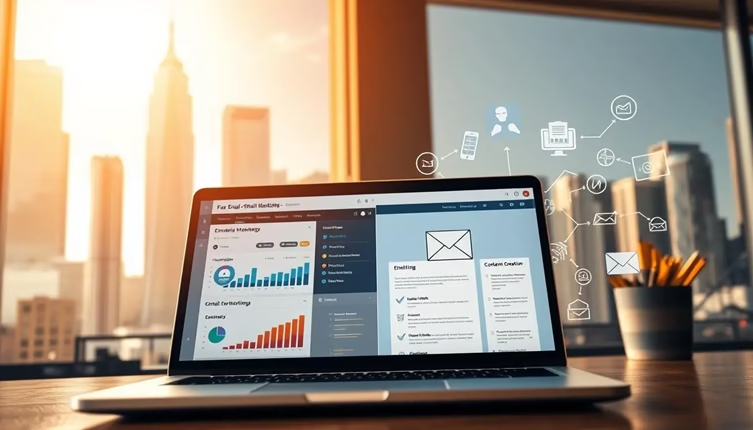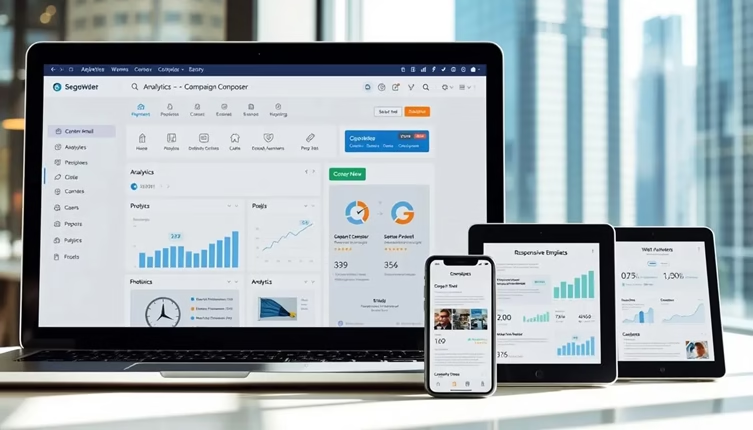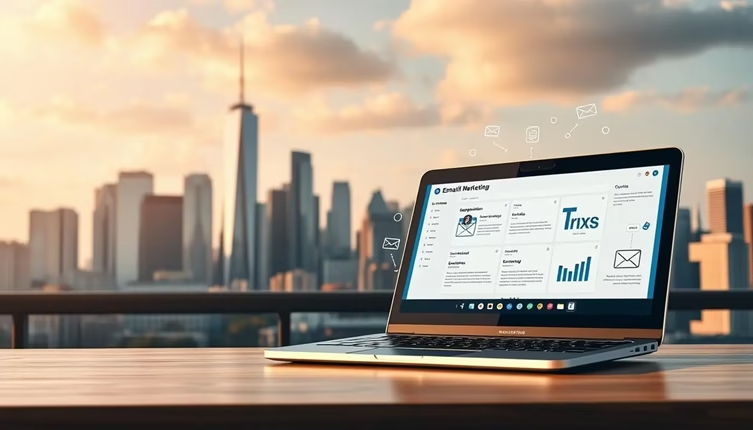
How do I start an email marketer? If you’re asking this question, you’re already taking the first step toward one of the most powerful digital marketing careers. Email marketing remains a key tool for businesses to engage audiences, boost conversions, and build long-term customer relationships. In this guide, you’ll learn everything you need to know—from essential skills to effective strategies—so you can confidently launch your career as an email marketer.
Table of Contents
Introduction
Email marketing is a powerful tool for businesses looking to engage their target audiences and sell their products. It promotes increased sales and marketing ROI. If you are asking, “How do I become an email marketer?,” you aren’t alone. As communication becomes increasingly important in online marketing, establishing yourself as an email marketer can lead to some amazing career paths.
This blog will walk you through everything you need to get started as an email marketer. It will also provide you with the tools and tactics that will ensure your success. Whether you are looking to change your career or you’re starting from scratch, this thorough guide will help you every step of the way.
After reading this blog post you will know exactly how to go about excelling in email marketing and laying out the roadmap for your career. Let’s begin!
What is Email Marketing?
Email marketing is a type of digital marketing in which a business sends emails to the target audience to communicate directly with them. These emails serve multiple purposes, such as selling products, providing valuable content, establishing connections, and engaging customers.
If you’re asking, “How do I start an email marketer?”, understanding what email marketing is and how it works is the first essential step.
Types of Email Marketing Campaigns:
- Welcome Emails: These are sent to newly registered subscribers to welcome them and tell them about the business or brand.
- Promotional Emails: Emails sent to the intended audience to notify them about special promotions, discounts, or new products being introduced are promotional emails.
- Newsletter Emails: Periodic mailings that include company headlines, important industry information, or other relevant materials.
- Re-engagement Emails: Emails sent to dormant subscribers to remind them of the brand.
- Transactional Emails: Emails that are sent as a result of some user activity like order confirmation, password resets, etc.

Why Start a Career in Email Marketing?
Whether you are considering email marketing as a full-time job or a side hustle, you are probably aware of the possibilities this field holds.
Over the years email marketing has emerged as one of the most in demand professions, majorly due to its effectiveness in growing businesses and nurturing clients. This is how pursuing a career as an email marketer is rational.
Benefits of Email Marketing as a Profession
- High Demand for Skilled Professionals:
As email marketing is more widely incorporated into business strategies, the need for email specialists has grown in e-commerce, technology sectors, even non-profits digital marketing teams. - Creative and Analytical Work:
Email marketing is very creative because you will have to write captivating copy for emails and at the same time understand data and analyze it for optimal campaign performance. - Remote Work Opportunities:
Email marketing offers freelance opportunities and remote work positions that allow you to do your work anywhere. - Personal and Professional Growth:
After gaining expertise in email marketing, one can apply knowledge in content generation, analytics, customer interaction, and marketing strategies.
Job Demand and Potential Income
- Job Opportunities:
Companies of whatever scale know the value of a skilled email marketer who can construct and lead an email campaign for their business. - Potential Earnings:
- Freelance Email Marketers: Can charge between $50 to $150 per hour depending on expertise.
- In-House Marketers: Average salaries range from $50,000 to $85,000 annually in the U.S., with senior positions earning even more.
- Specialist Roles: Expertise in areas like marketing automation or analytics can lead to higher compensation.
- Career Advancement:
Starting as an email marketer can open doors to broader roles, such as digital marketing manager, marketing strategist, or even chief marketing officer (CMO).

Skills Required to Become an Email Marketer
If you’re asking yourself, “How do I start an email marketer?”, the key is to develop the right set of skills. A successful email marketer will master both creativity and the technical side of crafting an ad that resonates with the audience and delivers measurable results. Everything starts with the following essential skills:
1. Writing and Copywriting Skills
• Creative subject lines, interesting email copy, and effective calls to action are crucial.
• Telling a good story will help you connect with and convert audiences.
• Email copy must be persuasive and impactful without losing its subtlety.
Tip: Practice writing variations of subject lines and email intros to boost your creative thinking.
2. Understanding Email Marketing Tools
• Understanding of email marketing tools like Mailchimp, HubSpot, ConvertKit, and ActiveCampaign is crucial.
• These tools aid in designing emails, automation of campaigns, and audience segmentation.
• Email templates, personalization, and automation workflows require horizontal proficiency as well.
Tip: Start by exploring the free versions of popular email marketing tools to get hands-on experience.
3. Data Analytics and Performance Tracking
- Analyze key performance metrics such as:
- Open rates: Percentage of recipients who opened the email
- Click-through rates (CTR): Number of users clicking links in the email
- Conversion rates: Users who completed the desired action (like making a purchase)
- A/B testing helps optimize emails by comparing subject lines, layouts, or CTAs.
- Data analysis allows you to refine campaigns and improve future performance.
Tip: Use built-in analytics dashboards in email tools to monitor campaign effectiveness.
Step-by-Step Guide to Becoming an Email Marketer
If you’re wondering, “How do I start an email marketer?”, following a structured path will help you break into this exciting field. Below is a step-by-step guide to becoming a successful email marketing professional:
1. Learn Essential Skills
To build a strong foundation, focus on developing key skills like:
- Copywriting: Master the art of creating persuasive email content, catchy subject lines, and compelling calls-to-action (CTAs).
- Design Basics: Understand how to create visually appealing emails using templates or custom designs.
- Analytics: Learn how to track and measure performance metrics such as open rates, click-through rates (CTR), and conversions.
- Segmentation and Personalization: Gain skills in tailoring emails to specific audience segments for better engagement.
How to Get Started:
- Take online courses from platforms like Coursera, HubSpot Academy, and Udemy.
- Practice writing sample emails and analyzing templates from top brands.
2. Choose the Right Email Marketing Platform
Selecting a platform that aligns with your goals is essential. Popular platforms include:
- Mailchimp: Great for beginners with easy-to-use templates and automation features.
- ConvertKit: Ideal for creators and bloggers who want advanced tagging and segmentation.
- HubSpot: Comprehensive tool for professional marketers with robust CRM features.
How to Choose:
- Look for tools with user-friendly interfaces, automation capabilities, and analytics features.
- Start with the free versions to gain familiarity before upgrading.
3. Set Up Your First Email Campaign
Once you’ve developed skills and chosen a platform, it’s time to launch your first campaign:
- Step 1: Build an email list by offering incentives like free guides or discounts.
- Step 2: Create a campaign with a clear goal—whether it’s product promotion or lead nurturing.
- Step 3: Write engaging subject lines and email content.
- Step 4: Test different versions of your email through A/B testing.
- Step 5: Analyze the performance and optimize future campaigns.
Pro Tip: Pay attention to the timing and frequency of your emails to avoid overwhelming your audience.
Best Email Marketing Tools for Beginners
If you’re searching for “How do I start an email marketer?”, one of the first steps is choosing the right email marketing tool. A good platform simplifies campaign creation, automation, audience segmentation, and performance tracking, even if you’re just starting out. Below are some of the top email marketing tools for beginners and a comparison of their key features.
1. Mailchimp
Why It’s Great:
- User-friendly drag-and-drop editor
- Pre-built email templates for quick customization
- Automation features for scheduling and follow-up emails
Best For: Beginners and small businesses
Free Plan Limitations: Up to 500 contacts and 1,000 monthly email sends
2. ConvertKit
Why It’s Great:
- Advanced tagging and audience segmentation features
- Great for creators, bloggers, and influencers
- Simple visual automation workflows
Best For: Content creators and personal brands
Free Plan Limitations: Up to 300 subscribers, basic email sequences
3. HubSpot
Why It’s Great:
- All-in-one CRM and marketing tool
- Built-in analytics and automation tools
- Professional templates and A/B testing features
Best For: Growing businesses and marketers seeking advanced features
Free Plan Limitations: Up to 2,000 emails per month
Why It’s Great:
- Powerful automation capabilities
- In-depth reporting features
- Seamless integration with third-party tools
Best For: Data-driven email marketers
Free Plan Limitations: No free plan but offers a free trial
5. Moosend
Why It’s Great:
- Budget-friendly pricing for small businesses
- Drag-and-drop email editor
- Detailed analytics dashboards
Best For: Small businesses with budget constraints
Free Plan Limitations: Limited features with a trial
Features Comparison Table
| Tool | Best For | Free Plan Contacts | Automation | Analytics |
| Mailchimp | Small businesses | 500 | ✅ | ✅ |
| ConvertKit | Content creators | 300 | ✅ | ✅ |
| HubSpot | Growing businesses | 2,000 | ✅ | ✅ |
| ActiveCampaign | Data-driven marketers | None | ✅ | ✅ |
| Moosend | Budget-friendly | Trial | ✅ | ✅ |
Building an Email List
One of the most crucial aspects of succeeding as an email marketer is building and maintaining a quality email list. If you’re wondering, “How do I start an email marketer?”, understanding the importance of growing an engaged list and learning the best strategies for list-building is key to your success.
Importance of Growing an Email List
- Direct Access to Your Audience:
An email list allows you to communicate directly with your subscribers without relying on social media algorithms. - Higher Engagement Rates:
Emails tend to have better open and click-through rates compared to other marketing channels, making it a powerful tool for engagement. - Personalized Communication:
With segmentation and targeting, you can tailor messages to specific customer groups, boosting conversions. - Long-Term Marketing Asset:
Unlike paid ads or third-party platforms, your email list is an owned asset that you can use for consistent communication.
Tips for List-Building
- Create Lead Magnets:
Offer valuable resources such as free guides, eBooks, or templates in exchange for email addresses.
Example: “Download our Free Email Marketing Checklist!”
- Use Signup Forms on Your Website:
Add prominent signup forms on high-traffic pages, including your homepage, blog posts, and landing pages. - Offer Exclusive Content:
Promise subscribers early access to promotions, discounts, or insider tips to incentivize signups. - Leverage Social Media:
Promote your email list on social media by highlighting the benefits of joining. - Run Contests or Giveaways:
Encourage users to enter contests by subscribing to your email list. - Personalize Opt-in Popups:
Use exit-intent or timed popups with targeted messages to capture visitor emails without being intrusive. - Ask for Referrals:
Encourage existing subscribers to refer friends and reward them for doing so. - Segment from the Start:
Allow subscribers to choose their preferences to receive more relevant content, increasing engagement.
Creating Effective Email Campaigns
If you’re searching for “How do I start an email marketer?”, mastering the art of creating impactful email campaigns is essential. Effective campaigns not only capture attention but also drive action, boosting engagement and conversions. Below are tips for crafting emails that stand out.
Email Design Tips
- Keep It Simple:
A clean, uncluttered layout helps readers focus on the message. - Use Visual Hierarchy:
Highlight key information with bold headings and section dividers. Place the most important content at the top. - Include Branding Elements:
Incorporate your logo, brand colors, and fonts to reinforce brand identity. - Responsive Design:
Ensure your emails are mobile-friendly and display correctly on all devices. - Use High-Quality Images:
Select professional, relevant images to support your content, but don’t overload the email. - Balance Text and Visuals:
Maintain a healthy balance between text and visuals to engage readers without overwhelming them. - Whitespace is Key:
Give elements room to breathe by using ample whitespace to enhance readability.
Crafting Engaging Subject Lines and CTAs
- Tips for Writing Subject Lines:
- Keep it short and impactful (around 6-10 words).
- Create a sense of urgency or curiosity (e.g., “Last Chance to Save 30%!”).
- Personalize where possible (e.g., “John, Don’t Miss This Exclusive Offer”).
- Test emoji usage for your audience preferences (🌟 or 🔥).
Examples:
- “Unlock Your Exclusive Discount – Limited Time!”
- “5 Tips to Boost Your Email Campaigns Today”
- Tips for Crafting CTAs (Calls to Action):
- Use clear, action-driven language (e.g., “Shop Now,” “Get the Guide”).
- Place CTAs where they are easy to spot, preferably above the fold.
- Test different colors and sizes to see what converts best.
- Personalize CTAs where possible (“Yes, I Want This!”).
Examples:
- “Claim Your Free Trial Now”
- “Get Started Today for Free”
How to Measure Success as an Email Marketer
If you’re asking, “How do I start an email marketer?”, knowing how to measure the effectiveness of your campaigns is essential. Monitoring key performance indicators (KPIs) and using A/B testing strategies will help you refine your campaigns and achieve better results over time.
Tracking Key Performance Indicators (KPIs)
- Open Rate:
- Measures the percentage of recipients who opened your email.
- Indicates the effectiveness of your subject lines and sender name.
Tip: Aim for a subject line that grabs attention without being spammy.
- Click-Through Rate (CTR):
- Tracks how many people clicked on a link within your email.
- Reflects the effectiveness of your email content and calls-to-action (CTAs).
Tip: Clear, actionable CTAs can help improve CTR.
- Conversion Rate:
- Measures how many subscribers completed a desired action (like purchasing a product or signing up for a service).
- Ties directly to the success of your campaign goals.
Tip: Make your conversion goals simple and easy to achieve.
- Bounce Rate:
- Tracks the percentage of emails that could not be delivered.
- A high bounce rate can hurt your sender reputation.
Tip: Keep your email list clean by removing invalid or inactive addresses.
- Unsubscribe Rate:
- Measures how many people opted out of your email list after receiving a campaign.
Tip: Always offer value in your emails to reduce unsubscribes.
A/B Testing Strategies
A/B testing (split testing) involves sending two variations of an email to different subsets of your audience to see which performs better.
- Subject Line Testing:
- Test different tones, lengths, or formats.
- Example: “Limited Time Offer!” vs. “Unlock Your Exclusive Deal Now.”
- CTA Testing:
- Experiment with different button colors, text, or placements.
- Example: “Buy Now” vs. “Shop the Collection.”
- Email Layout:
- Compare different design elements, such as single-column vs. multi-column layouts.
- Send Time Testing:
- Test sending emails at different times to find when your audience is most engaged.
- Personalization:
- Test including personalized content, like the recipient’s name, versus more general messages.
How to Conduct A/B Tests:
- Test one variable at a time for accurate results.
- Set a clear metric (e.g., open rates or CTR) to determine success.
- Run tests on a large enough audience sample for meaningful insights.
Conclusion and Final Tips
Starting your journey as an email marketer can be rewarding and impactful. If you’ve ever wondered, “How do I start an email marketer?”, this guide has provided the essential steps, skills, and strategies to help you get started and thrive in this dynamic field.
Key Points Recap
- Understand the Basics: Learn what email marketing is and why it’s an essential part of digital marketing.
- Build Core Skills: Develop copywriting abilities, familiarize yourself with email marketing tools, and master data analytics.
- Select the Right Tools: Start with beginner-friendly platforms like Mailchimp or ConvertKit to simplify your workflow.
- Focus on List-Building: Create compelling lead magnets and leverage multiple channels to grow your email list.
- Craft Effective Campaigns: Write engaging subject lines, design visually appealing emails, and include strong CTAs.
- Measure and Optimize: Track KPIs such as open rates and conversions, and use A/B testing to continually improve your campaigns.
Actionable Tips for Beginners
- Start Small: Focus on creating simple, targeted campaigns rather than trying to master everything at once.
- Learn from Data: Analyze each campaign to see what works and what doesn’t—adjust your strategy accordingly.
- Stay Updated: Email marketing trends and tools are constantly evolving. Keep learning through courses, blogs, and webinars.
- Segment Your List: Even with a small list, segmentation improves engagement by delivering more relevant content.
- Keep Testing: Experiment with subject lines, email formats, and CTAs to optimize your campaign results.
Q&A: Frequently Asked Questions About Starting as an Email Marketer
1. How do I start an email marketer without prior experience?
Start by learning the basics of email marketing through online courses, blogs, and tutorials. Practice using beginner-friendly tools like Mailchimp or ConvertKit to create and manage simple campaigns. Building a portfolio with sample campaigns can also help demonstrate your skills to potential employers or clients.
2. What are the key skills required to succeed in email marketing?
You need strong writing and copywriting skills, a good understanding of email marketing platforms, and the ability to analyze data for campaign optimization. Creativity, attention to detail, and a results-driven mindset are also valuable traits.
3. How do I grow an email list quickly?
Offer lead magnets like eBooks, discounts, or exclusive content in exchange for subscribers. Promote your sign-up forms on your website, social media, and other digital platforms. Running contests or giveaways can also be effective for rapid list-building.
4. Which email marketing platform is best for beginners?
Mailchimp, ConvertKit, and Constant Contact are great options for beginners. They offer user-friendly interfaces and templates to help you create and manage email campaigns without needing advanced technical skills.
5. What are the most important KPIs to track for email campaigns?
Track open rates, click-through rates (CTR), conversion rates, and unsubscribe rates. Monitoring these KPIs helps you identify what’s working and where improvements are needed.
6. How often should I send emails to my subscribers?
It depends on your niche and audience. Generally, one to three emails per week work well for many industries. However, consistency is key—ensure your schedule aligns with subscriber expectations and content value.
7. What makes a good subject line for an email campaign?
A good subject line is short, clear, and compelling. It should spark curiosity, highlight a benefit, or create urgency. Personalization and the occasional use of emojis can also increase open rates.
8. How can I reduce unsubscribe rates?
Provide valuable, relevant content that meets your audience’s expectations. Avoid excessive promotional emails, and allow subscribers to customize their preferences to receive only the type of content they want.
9. Is A/B testing necessary for every campaign?
While not mandatory, A/B testing is highly recommended for optimizing email performance. It helps you discover the most effective subject lines, designs, and CTAs, leading to better engagement and conversions over time.
10. How long does it take to become a successful email marketer?
The timeline varies based on your learning curve and practice. With consistent effort, you can build foundational skills within a few months and start seeing tangible success in your campaigns.
Affiliate Disclaimer
At Expert Tool Reviews (https://bestone4u.com), we may earn a commission when you click on affiliate links and make a purchase. This comes at no extra cost to you and helps support our efforts to provide honest and thorough reviews of digital tools and services.
We prioritize providing accurate and unbiased information to help you make informed decisions. All recommendations are based on our personal experience or extensive research.
This site is part of affiliate programs including but not limited to Warrior Plus and JVZoo, which are recognized affiliate networks. If you have any questions, feel free to contact us via the website.



